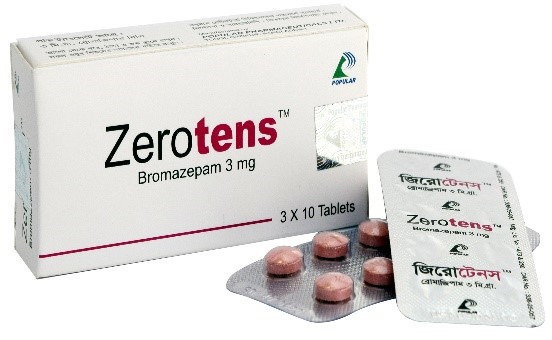Indication
Emotional Disturbances: Acute tension and anxiety states, difficulties in interpersonal contact, agitation, insomnia, anxious and agitated depressive reactions. Functional disturbances in the cardiovascular and respiratory systems: Pseudoangina pectoris, precordial anxiety, tachycardia, emotiogenic hypertension, dyspnea and hyperventilation. In the gastrointestinal system: Irritable bowel syndrome, epigastric pain, spasm, bloating diarrhea etc. In the genitourinary system: Frequency, irritable bladder and dysmenorrhea. Psychosomatic disorder: Psychogenic headache, psychogenic dermatosis, asthma, gastric and duodenal ulcer and ulcerative colitis. Emotional reactions to chronic organic disease. Adjuvant to psychotherapy in psychoneurosis.
Dosage & Administration
Standard dosage: Average dosing for outpatient therapy: 1.5-3 mg up to three times daily. Severe cases, especially in hospital: 6-12 mg two to three times daily. These amounts are general recommendations and dosage should be individually determined. Treatment of outpatients should begin with low doses, gradually increasing to the optimum level. The duration of treatment should be as short as possible. The patient should be reassessed regularly and the need for continued treatment should be evaluated, especially if the patient is symptom free. The overall treatment generally should not be more than 8-12 weeks, including a tapering-off process. In certain cases, extension beyond the maximum treatment period may be necessary, if so, it should not take place without re-evaluation of the patient\'s status with special expertise. Special dosage instructions: Bromazepam is usually not indicated in children, but if the physician feels Bromazepam treatment is appropriate, then the dose should be adjusted to their low bodyweight (about 0.1-0.3 mg/kg bodyweight). Elderly patients and those with impaired hepatic function require lower doses because of individual variations in sensitivity and pharmacokinetics.
Precautions
Dependence: The use of Benzodiazepines and Benzodiazepine-like agents may lead to the development of physical and psychological dependence upon these products. The risk of dependence increases with dose and duration of treatment. Withdrawal: Once physical dependence has developed, termination of treatment will be accompanied by withdrawal symptoms. These may consists of headaches, muscle pain, extreme anxiety, tension, restlessness, confusion and irritability. In severe cases, the following symptoms may occur: derealization, depersonalization, hyperacusis, numbness and tingling of the extremities, hypersensitivity to light, noise and physical contact, hallucinations or epileptic seizures. Amnesia: Anterograde amnesia may occur using higher therapeutic dosages (documented at 6 mg) the risk increasing at higher dosages. Specific patient groups: In patients with myasthenia gravis who are prescribed Bromazepam, care should be taken on account of pre-existing muscle weakness. Particular care is required in patients with chronic respiratory insufficiency due to the risk of respiratory depression. Effects on ability to drive or to use machines: Sedation, amnesia and impaired muscular function may adversely affect the ability to drive or to use machinery. This effect is increased if patient has taken alcohol. Pregnancy and nursing mothers: The safety of Bromazepam for use in human pregnancy has not been established. As Benzodiazepines pass into breast milk, nursing mothers should not take Bromazepam.






